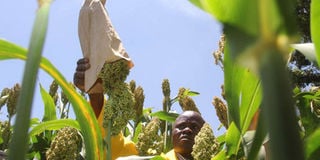The good and bad of making silage from sorghum fodder

Collins Oduor, product promotion assistant at Kenya Seed Company covers the heads of a sorghum crops to protect them against bird attacks. Sorghum is becoming an appealing substitute to maize as farmers search for drought-friendly crop solutions. FILE PHOTO | NATION MEDIA GROUP
What you need to know:
- Sorghum fodder has almost similar protein content to maize.
- Sorghum, in particular, is becoming an appealing substitute to maize as farmers search for drought-friendly crop solutions.
- A dairy producer may not need to know how to calculate and find the right balance, but would have to supplement the feed with other feed sources or feed more grains to achieve the same starch, rumen fill and digestibility provided by maize silage.
- Sorghum silage, depending on varieties, is certainly more suited for livestock with lower energy requirements than lactating cows, for instance heifers and dry cows.
Corn, also known as yellow maize, is a popular forage among dairy farmers grown for making silage for use especially during the dry season.
Numerous challenges, mainly water shortages, plant attack by specific pests and lack of seeds, however, lure dairy producers into planting alternative crops.
Sorghum, in particular, is becoming an appealing substitute to maize as farmers search for drought-friendly crop solutions.
Forage sorghum, a member of the sorghum family, is a hardy, drought-tolerant plant that can thrive under little rainfall or limited irrigation, making it a logical choice for areas facing water challenges.
Moreover, sorghum forage seeds are much less expensive than those of maize and the input costs needed are lower than for maize fodder.
Further, sorghum fodder may in turn yield nearly the same tonnage per acre as maize fodder, ranging from 15 to 30 tonnes depending on the type of soil, weather and variety.
Despite these, there are differences when it comes to overall forage quality, thus special considerations are needed when growing and harvesting sorghum for silage making.
Again, many farmers fear producing sorghum as fodder citing death of cows when fed. Well, this may be true, but why? How?
Forage sorghum is associated with prussic acid poisoning or nitrate toxicity.
Prussic acid occurs mostly in young plants or when plants are harvested shortly after frost or drought-ending rain.
PRODUCTION LOSSES
Nitrates, associated with harvesting a heavily manured/fertilised crop during or immediately following a severe stress like drought, on the other hand, can be a problem with both forage sorghum and maize.
Cows grazed on sorghum plants directly are susceptible to these problems.
Prussic acid is volatile hence dissipates during ensiling process making the poisoning controlled for sorghum silage.
Therefore, these problems are not normally a concern when sorghum forage is harvested for ensiling.
However, questionable sorghum forages should not be used or should be tested first.
Sorghum fodder has almost similar protein content to maize, but is slightly lower in energy and has lesser starch.
This means sorghum silage cannot serve as a full replacement of maize silage, thus should be supplemented.
Starch is an important factor because it can directly impact feed intake, milk production and its components levels.
Low-starch diets like sorghum forage affect rumen-degradable starch required in the diet.
A dairy producer may not need to know how to calculate and find the right balance, but would have to supplement the feed with other feed sources or feed more grains to achieve the same starch, rumen fill and digestibility provided by maize silage.
However, overfeeding starch, especially in the form of grain can cause problems like lowering feed intakes, too much acid (rumen acidosis) and depressed milk fat percentage hence production losses.
SUITED FOR LOW ENERGY REQUIREMENTS
While sorghum fodder has high biomass yields, its digestibility is generally less than that of maize on account that corn has less lignin and more grains.
This can result in less fibre digestion, lower dry matter intake and lesser milk produced.
Even though research has looked into improving digestibility and manipulating sorghum lignin content in the leaves and stalks, the resulting improved varieties and genotypes that can support milk yield and component composition comparable with that of maize silage still remains unavailable in the local market.
In summary, there are considerable quality differences between sorghum and maize forage varieties commercially available for silage production.
Inclusion of sorghum fodder into the forage crop farming system though, allows farmers to obtain a more economic product, especially where water is the first limiting factor.
Sorghum silage, depending on varieties, is certainly more suited for livestock with lower energy requirements than lactating cows, for instance heifers and dry cows.
Opinya is based at the Department of Animal Science, Egerton University.




